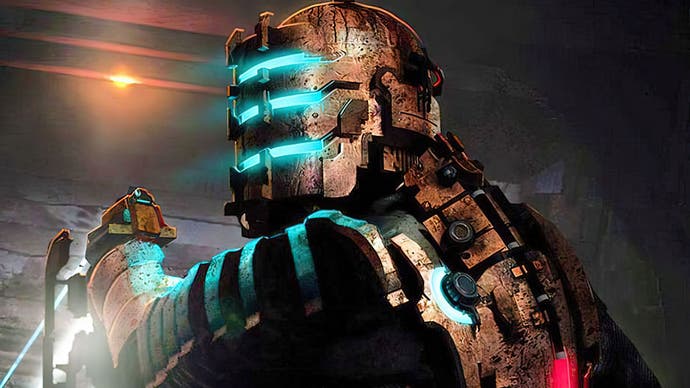Dead Space remake: post-patch PS5 + Series X/S performance analysis
Have image quality improvements come at a cost?
The original Dead Space was a survival horror masterclass - a highly atmospheric and tense action game that exploited seventh-gen console hardware to deliver something really special. Some fifteen years and two console generations later, Dead Space has been fully remade with modern tools, sporting excellent new artwork, sophisticated rendering features, and revamped level layouts and content.
As John has covered in detail, Dead Space is on the whole a successful remake effort. However, the game arrived with serious issues, including completely unlocked frame-rates on the console's quality modes (and Series S) in the preview code, resulting in extremely uneven performance, then serious image quality problems with the day one patch applied, with current-gen consoles sporting a raw, aliased presentation. For better and worse, updates have come in hot and fast on this one, requiring not one but two restarts of our coverage - hence the late arrival of this comparison piece.
Now reports online suggest that the game’s visual woes have indeed been addressed. So what’s the current state of the game on current-gen? And do these image-salvaging measures hurt performance?
So to recap: at launch, Dead Space had some very awkward image quality characteristics for a current-gen game. The PS5 version in particular exhibited some very strange artefacts in virtually every shot. Geometric edges often looked jagged and serrated, a sort of stippled artefact pattern that looked almost like a chainsaw blade. In stills this was unpleasant enough, but in motion it meant that the PS5 version suffered from a lot of edge aliasing. Textures resolved oddly as well, appearing blocky and suffering from breakup on fine details. Again, these were temporally unstable, leading to a lot of flickering when the game was in motion.
The Xbox versions of the game also had issues, though their image quality woes were somewhat less pronounced. Granted, we did see artefacting in the same spots as on PS5 - but the artefacting looked totally different. The image artefacts gave textures and edge detail a crude, low-resolution look, blending in a bit better than on Playstation.
Ultimately, this seems to have come down to the use of variable rate shading (VRS). This technique reduces the shading rate in parts of the image where it's less likely to be noticed, easing GPU load. Dead Space originally used the technique extensively in most areas that were in or around shadows, which given the setting meant that a lot of the game suffered from a loss in detail and heavy artefacting - not really meeting image quality standards for a modern game. The PS5 doesn't support hardware VRS, so a software solution that exploited the MSAA functions of the PS5’s GPU was implemented. Something within the software VRS didn’t seem to be working correctly though, producing the obtrusive artefacts we described.
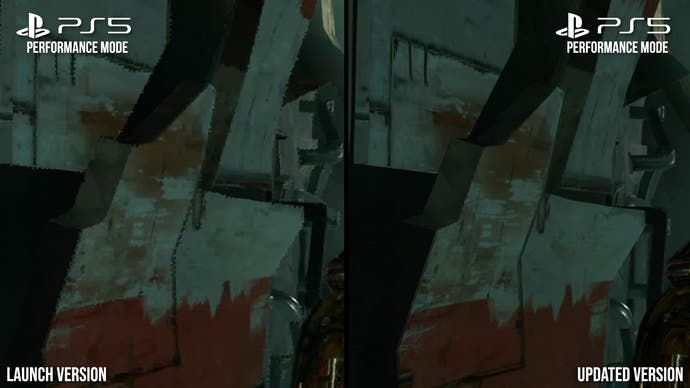
Now the game is in a much better place, as VRS has been removed entirely. This boosts image quality substantially, both on PS5 and Xbox Series consoles. The game isn't visually perfect, as edges can break up a bit in motion and there are some temporal accumulation artefacts present, but the game now generally reaches the same level as other current-gen titles - smooth, detailed and attractive.
To balance detail and performance, all consoles use AMD's FSR 2.1.2 image upscaler which uses a relatively low internal resolution and scales to a higher output resolution. This varies by mode, as visible in the table below. Note that we do understand the game to have a dynamic resolution system, but this wasn't demonstrated in our pixel counting. It's also interesting that the game doesn't seem to have suffered much from the removal of VRS, as pixel counts are nearly identical before and after the feature was removed in the latest patch - perhaps the game had enough GPU overhead to minimise any performance differential, though this calls into question its inclusion in the first place...
| Pixel count | FSR 2 output resolution | |
|---|---|---|
| Series S | 900p | 1440p |
| PS5 (performance) | 936p | 1440p |
| Series X (performance) | 972p | 1440p |
| PS5 (quality) | 1296p | 2160p |
| Series X (quality) | 1296p | 2160p |

Beyond resolution and image quality, there's little to separate the various modes and consoles. Series S does exhibit differences in ambient shading, but it's not a major regression compared to Series X and PS5.
Similarly, the quality modes on Series X and PS5 offer ray-traced ambient occlusion (RTAO), which fills in pockets of shade much more realistically than the SSAO that is otherwise present, darkening areas in line with the way light should be occluded. This is most noticeable in the corners of rooms, or the undersides of larger structures, spots where the occluding geometry is relatively distant from the shaded area. These now have a sort of pleasing gradient that stretches from inky black to fully lit, whereas the SSAO tends to have a more uniform appearance and struggles to handle certain kinds of complex geometry. It's an appreciated visual boost, although the lighting is still very pleasing with SSAO. But the RTAO gives the game that extra bit of fidelity where it counts, and its application really suits Dead Space's visual design, which relies heavily on indirect lighting.
So on the image quality front, Dead Space is much-improved after the latest patch - but have these changes come at at the cost of performance?
Let's start with the Xboxes. Series S has one visual mode, which targets 30fps. Fortunately, this is a close-to-locked 30fps update, delivering a solid 30 even in challenging content. There are one or two moments where the game can drop frames - specifically during a dramatic cinematic sequence in the early game - but it's almost a locked 30. A 60fps option would have been nice of course, and the Series S version actually had an unlocked frame-rate during the pre-launch review period, typically floating between 40 and 60fps. 30fps is definitely a good call to balance image quality and frame-rate fluidity on the console, but an alternate mode that took a further resolution hit for better performance would be appreciated, like we see on the other platforms.
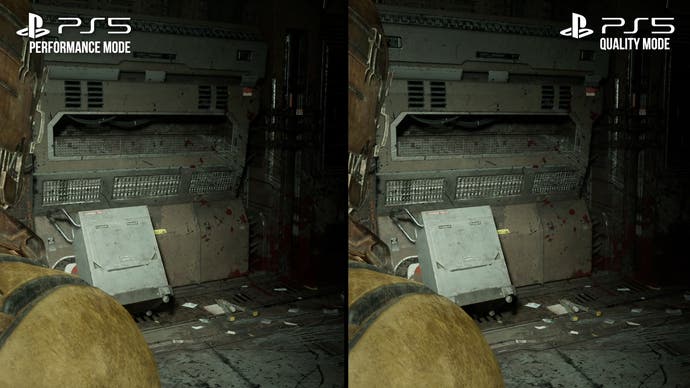
Series X defaults to a performance mode that targets 60fps, which is again pretty solid. There are more frequent drops here, but they're usually isolated to one or two frames within a few seconds - the kinds of frame-rate dips that many players won't notice. The same cinematic that causes significant drops on the S exhibits the same behaviour here as well, but other taxing moments play back at a locked 60. I couldn't get the quality mode to drop frames at all though, so it sails by at a locked 30fps. It's possible that it could dip in select circumstances, but if so it's quite rare.
The PS5 version targets 60fps by default with its Performance mode, which again generally holds steady. There are somewhat more significant frame-rate stumbles here - the one-off frame drops on Series X are often a bit more prolonged on PS5 - but it's otherwise locked. It's a little bit more unstable, but I didn't spot anything really egregious. The quality option is basically a perfect mirror of Series X, though, running at a perfectly stable 30fps in my testing.
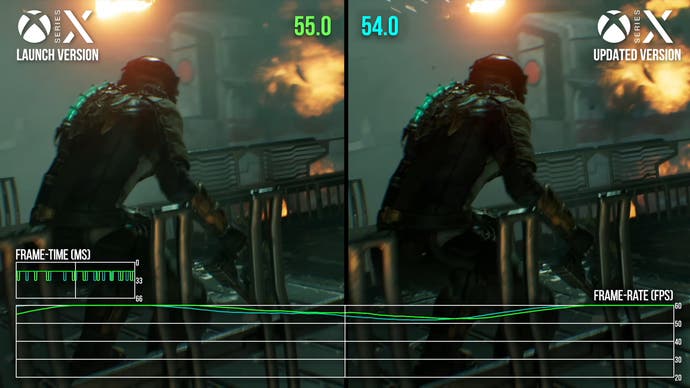
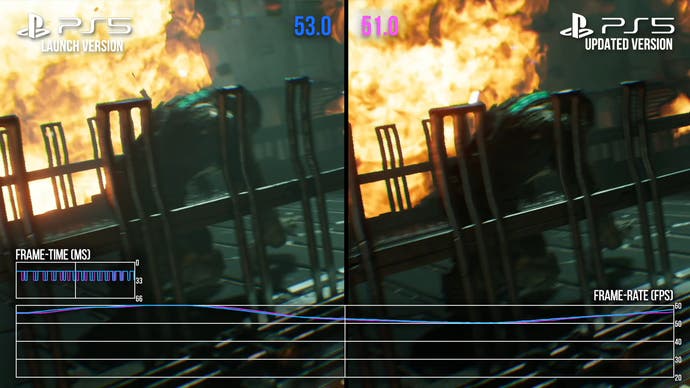
And to answer the question posed earlier, there doesn't appear to be a significant regression in terms of performance after the patch - frame-rates might be slightly down in some scenes, but not to any extent that's worth worrying about.
Beyond the basic frame-rate numbers, there was one other issue I wanted to raise, which affects all console platforms on occasion. During traversal, the game can momentarily pause for a few frames in select instances - like when going down this ramp in chapter three. The game is still technically updating the image each frame if you look closely, but it otherwise behaves like a short stutter.
Ultimately though any performance issues don't amount to anything more than minor quibbles. Dead Space's frame-rates aren't faultless, but the game offers a stable experience across all console platforms, with the latest patch exhibiting nearly identical resolutions and performance as the launch version, yet with a much cleaner presentation and significantly improved image quality.
As a big fan of the original Dead Space, I'm really impressed with the overall quality of this remake. It has been overhauled top-to-bottom, but it still feels like the source game in all the ways that count. It helps of course that it looks excellent throughout, with beautiful visual design and high-quality assets combined with capable Frostbite rendering tech. EA Motive has produced one of the most accomplished remake efforts in recent memory.
It’s a good thing that the game is so fun too, given that this is the second full console comparison piece I’ve made on Dead Space - the initial video and accompanying article were fully produced and ready to go just as we got word that a fix was incoming for the game’s image quality issues. So late last week, once the update was available for all consoles, I got back to work - and the magnitude of the improvement was immediately obvious.
So now that the game's most contention performance optimisation has been jettisoned, the console releases are in excellent shape and come with a warm DF recommendation.
